My first post about the Kalalau trail has generated the most comments of any so far. It is after all the highlight of any trip to Kauai for the physically inclined. But from the emails I keep receiving, it seems like details are scarce. The discussion in that post has turned to the “hippies” who “inhabit” Kalalau valley, so I’ll start a second post with another set of questions. Rachel asks:
Q: I am determined to make it to Honopu Beach, what is the best way to get there, some places say you can walk along the rocks, while others say to swim. We will be there the second week in June ’07. How hard is it really?
A: You must have been reading the “Ultimate” Kauai Guidebook where Honopu beach is called “the most beautiful beach in all the islands, maybe in all the Pacific.” Now I have a lot of respect for the guidebook authors, with all the places they’ve revealed and all the great photos they’ve published, but they do have a tendency to hype (and brag about) the most deserted and most difficult places to access (remind me to blog about the “tunnels” hike someday). What you should know about Honopu beach is that although it is beautiful and unique, sitting at the base of sheer cliffs and bisected by a towering arch, I don’t find it as aesthetic as Kalalau beach (see the first two photos in that other post). At Honopu, the cliffs are a bit foreboding, the arch is massive and asymetrical, the waterfall is mostly hidden and the beach itself has no trees, no shade and only a few dunes to add interest.
But the attraction of Honopu is undeniable: a deserted beach whose isolation almost guarantees you’ll be alone (though not unseen from kayakers and helicopters), and exploring it gives you a good adrenaline rush. There is only one legal way to reach Honopu beach, and that is to swim there. Landing a craft of any sort at Honopu is illegal, even a surfboard I believe. Be aware that the swim involves choppy waves, currents and unpredictable conditions, even in the summer when the ocean is relatively calmer. You should not even consider this swim outside the summer months.
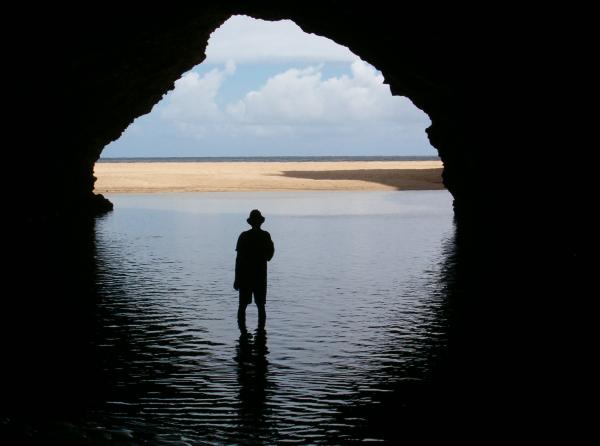
The third sea cave from Kalalau beach, the first with water
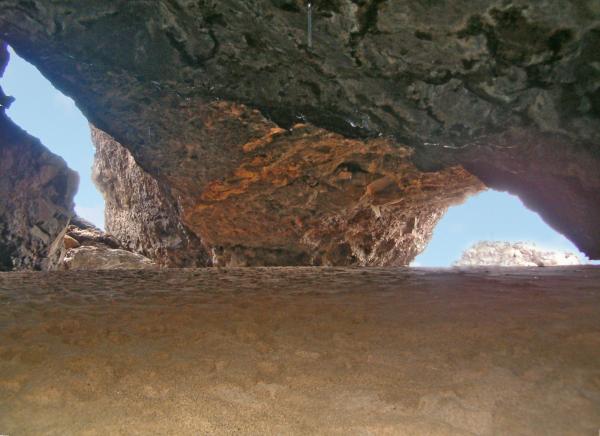
The two entrances make this cave a candidate to be a future sea arch
During the summer, the relatively calmer seas bring sand onto Kalalau beach, making it walkable for almost a half mile past the campground. You will go past several sea caves on the beach, some with small lagoons trapped inside by the enlarged beach. The last cave opens where the rock face blocks the beach, but you can go through the cave (usually dry) out to a small beach on the other side. There seems to have been some sort of rockslide that opened up this beach from the cave, and there are huge boulders strewn on the beach. When I went, I swam from here:

Start swimming just to the left of this house-sized boulder
You might be able to hike a bit further along the rock face, but I believe you will reach a point where it will be impossible to pass. Anyways, you would be battered by waves, even small ones, making it safer to be swimming in the water. So, if the seas are not rough, if you feel confident in your ability to swim in the ocean, and if you agree to not hold me liable, here is where you start swimming. From that last beach, you cannot see Honopu beach, it is around the corner of the cliff. I estimate it’s about 100 meters to the corner, and another 100 around to the beach. That’s 4 laps in an olympic pool (50 meters in length), so I recommend you be able to swim 10 laps to give yourself a large margin of safety. Also, you will be swimming against the current when you return, so you should be prepared to swim about 15 minutes continuously. Please do not attempt this if you have no experience swimming in the ocean.
Two suggestions: if you are determined to make it, bring a snorkel and mask or at least some fins. That should make the swim easier though you will curse the extra weight on the Kalalau trail. I suppose you could also bring a small inflatable device (children’s floats or camping pillow) for safety. If you collect sea shells, bring a small ziplock bag and make sure you have closable pockets to put it in, because deserted beaches are your best chance to find sunrise shells.
A friend here on Kauai has written about his adventures in Honopu, sometimes known as the Valley of the Lost Tribe. It’s the only other account I’ve found on the web about swimming to Honopu, and I do not recommend you follow his lead and climb into the valley. Remember that the main reason for going to Honopu is to explore further off the beaten path, but that involves further risk. So if conditions are not favorable or you are unsure of your ability, it is best to just stay and enjoy Kalalau Beach.
Update: I just found another account of swimming to Honopu on a new blog. It pretty much confirms what I say here.
Q: I am trying to fill out my camping permit, but am not sure what
campsites we will be staying at each night. We plan to backpack for 5
nights and really enjoy the trail, do you have a suggested itinerary
for me?
A: In the other post, I gave my ideal schedule for 4 nights and would just extend that with an extra day and night in Kalalau. But that supposes you are a strong hiker (hiking every week, backpacking every month), so if you feel you can’t hike out in one day, reserve the last night at Hanakapiai Hanakoa again. Or even if you are a strong hiker, you might want to add the side trips to Hanakapiai falls the very first day and Hanakoa falls on the way out, and thus plan to stop at Hanakapiai both ways.
Update July 2007: camping restrictions have changed, and permits are now given for Hanakoa instead of Hanakapiai. I had previously heard camping was restricted at Hanakoa to preserve the archeological sites (rock walls and terraces), but Hanakapiai was becoming so overused that the park managers decided its sites were now more at risk. Hanakoa is the more logical half-way point to camp, and people were camping there anyways, but I still find it to be too muddy, muggy, and buggy.
See the official Na Pali permit procedures webpage if you haven’t already. Hanakoa camp at the 6-mile marker is closed, and so Hanakapiai is your only legal option. In case of an emergency, and that would include getting caught by darkness, I think you would be justified in bivouacking at Hanakoa Hanakapiai. There is also a heliport near the 8-mile marker, with small terraces on the other side of the trail where you could set up an emergency bivouac. The section of trail beyond that point is the worst eroded, so you really don’t want to do it in the dark even if you have head-lamps or flashlights.
As long as you have a paid permit for a given night, you will most likely be forgiven if you camp in the wrong place and get caught by a ranger (let me know if that’s not the case). That means that if you plan to hike out in one day, but then realize after the hike in that you’d rather not, it’s better to leave a day early and spend that night in Hanakapiai rather than make an unpermitted stop there.
Personally, we don’t camp at Hanakapiai when hiking out because by then we just want to get back to our home. But those last two miles are hard after the first nine, and the throngs of day hikers returning from Hanakapiai don’t make it easy to maneuver a large pack. So you should really evaluate how you handled the hike going in and decide if you’d gain anything by pushing yourself to get out in one day.
Q: Are there any places along the way we should make it a point to stray off the trail for that the books don’t tell you about?
A: The major side trails are Hanakapiai and Hanakoa falls, which are in the guidebooks, but I’ll mention them here as part of a Kalalau trip. As nice as they are, I usually don’t recommend them for people only going for 2-4 days. However, you will have extra time, so you could fit them in. Hanakapiai falls are 4 miles roundtrip from the beach, on a muddy trail and rock-hopping a bit in the stream. That’s a good half-day hike in itself, so I recommend you do on the first day if you leave early and camp at Hanakapiai afterwards. You could always go on your last day if you camp at Hanakapiai, but like I said, you might just want to hike out and rest by then.
Hanakoa falls are only a half-mile (less than 1 km) from the main trail and well worth the detour (see photo on the right below). The problem is that you may not have time for that extra hour if you’re behind schedule going in or trying to get out in one day. My recommendation is to skip it on the way in, to make sure you reach Kalalau before dark (not only for safety but also for the views), and do it on the way out if you have time (based on your schedule going in). The trail begins near the shelter on the SW (Kalalau) side of Hanakoa stream. You can go through the shelter and out the back to the left, but I think the real trail starts one or two terraces below the shelter. The trail is unnmarked and faint, but it’s the only way to go (it crosses a side stream but stays on the left bank of the main stream). At one point near the falls, the trail is eroded on a ledge high above the stream, so step carefully.
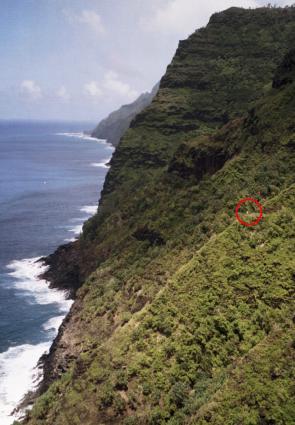 |
 |
Hanakoa valley also has two viewpoints that reward the adventurous hiker. At both points where the trail turns to go into and out of the valley, there is a small ridge that continues toward the ocean. Leave your pack by the trail, grab your camera, and scramble through the bushes onto these rocky outcrops. You can’t go too far until it gets steep, narrow, and dangerous, but that extra perspective gives you great views up and down the Na Pali coast and into the valley. I believe the photo on the left above is from the NE ridge, and you can see my wife hiking further down the trail towards Kee, itself visible at the end of the cliffs.
In the original post, I mentioned Space Rock, which I call the Gate because that’s more what it looks like. It’s where the trail squeezes between a large boulder and the cliff face, around the 3.5 mile-mark, after leaving Hanakapiai and just before entering the first major valley of Hoolulu. This is the highest point on the trail at over 700 feet (over 200m), and if you are not subject to vertigo, you can walk around the rock and look straight down into the ocean.
In Kalalau valley, I’ve also described how to get to Big Pool. Several sources mention Davis Falls, which are the major falls on the N wall of the valley that you can see from the Kalalau lookout and from one point on the trail to Big Pool. The Boy Scouts actually built a trail to the falls but it was cut off by damage from the hurricanes, and then lack of use made it disappear. I have explored some other trails in the valley, and people have told me where to find that one, but I’ve never really looked for it. Maybe some of the “resident” hippies can tell you, and then you can share it with us here.
One place to find those “residents” and more views of the Na Pali is on the bluff between Red Hill and the stream crossing. The easiest way to find it is to walk back to the base of the eroded Red Hill you descend on into the valley and then cross the grassy bluff to the cliff edge. You can get down to a boulder beach to the right, and there is a faint trail that loops around to left on the bluff, joining the main trail just above the stream.
Finally, there are many views from the trail itself, just look up and look back often to see them. There are also some possibilities for exploring elsewhere off the trail, but I don’t know many of those and none lead to new viewpoints. If you do feel like exploring off trail, please walk carefully to avoid causing erosion and killing plants that prevent erosion, and do not disturb any ancient rock walls you might find.
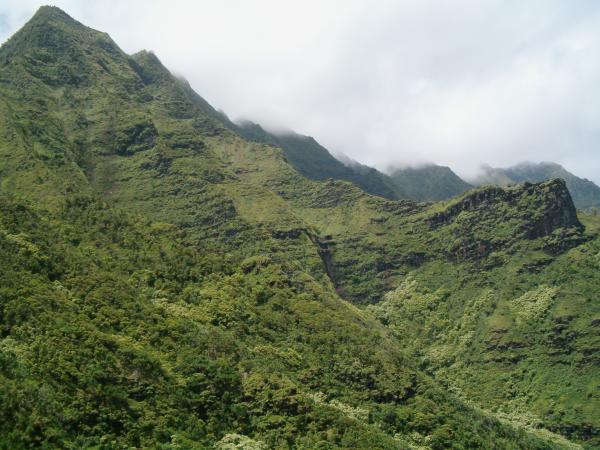
Looking up at the mist-shrouded peaks above what I think is Waiahuakua valley
Q: Is catching fish a feasible feat? We obviously don’t intend to base
our food supply on that, but something sounds cool about catching a
fish for dinner while on the trail.
A: The only places you reach the ocean are at Hanakapiai and Kalalau Beaches, so you’d most likely be fishing from your base camp in Kalalau. Shore casting is practiced widely throughout Hawaii, from both rocky shores and sandy beaches, and I suppose Kalalau would be as good a place as any. I am not a fisherman in any way, so I have no idea what fish would be worth catching, nor how you would go about it. I do see that most have long poles and weighted lines, neither of which are practical for backpacking, and to be honest, I’ve never seen a shore-caster catch anything (in Hawaii, night fishing is legal but sleeping on a beach is not, so I think that catching something is not always the goal). Come to think of it, I did see someone taking a pole into Kalalau, but I have no idea if they were successful. Another option if you snorkel is to go spear-fishing, but I don’t know anything about that either.
Food for long backpacking trips is always a problem. The two hiking stores in Hanalei, Peddle and Paddle and Kayak Kauai, both carry freeze dried meals, though it will be cheaper to bring from the mainland I imagine. Because those are usually bland and oversalted, we have moved towards other calorie-dense foods. The organic food store in Kapaa (Papaya’s, near Safeway) has powdered soups, hummus, and refried beans in bulk (be sure to pack them in stronger bags before hiking). Mix those with filtered or boiled water and some olive oil, and roll inside tortillas, for a hearty and healthy meal. We also take ramen soup packets and add garlic, peanut butter, and oil to the cooked noodles.
Q: How busy is the trail at this time of the year?
A: The trail between Hanakapiai and Kalalau is never busy. I think there are 60 permits per night in the summer, but many are kayakers. So you probably only have 10-15 people going each way beyond Hanakapiai each day. It’s enough to make you feel secure knowing that if you have a problem, someone will be along in a few hours, but not so much that you loose that sense of getting away from it all. If you stop at the places I mention above, you will most likely have them all to yourself for a while. The rest of the year, there are even fewer people on the trail, but between all the people I hear from and the “hippies” who hike it regularly, I doubt you’ll ever be all alone.
I have mentioned the throngs of day-hikers between Kee and Hanakapiai above, probably 100-200 on a sunny day. Between 10am and noon, most are hiking in, and from 2pm to sunset, they all hike out. You probably can’t avoid them, so it’s best to know you won’t be making good time on that section, either getting behind slow people or having to stop when crossing large groups. After the splendid solitude on the rest of the trail, it can be annoying, but you can see it as a preparation for getting back to “civilization” and feel a little smug knowing that those 2 miles are what 95% of the tourists consider the Kalalau trail experience.
Q: I keep seeing over and over that the beaches along the trail are
not safe and not to go in them, is there any good swimming/snorkeling
along the way?
A: Again, the trail reaches sea level only at Hanakapiai beach and Kalalau Beach. Anywhere else in between there are dangerous cliffs below the trail, and the coast inaccessible for all intents and purposes. Hanakapiai is the treacherous beach with the most drownings on Kauai, so no one will suggest you go swimming there. It is a tiny bay between large cliffs, and the offshore currents combine with the large stream to create unpredictable rip currents in the bay. People die because they get swept out to the open ocean, not back to shore, and even if they do reach the rocky shore there is no way for a weakened person to climb onto the wave-battered cliff.
Kalalau is a different story. It is a long sandy beach where you can see up and down the coast. There is still a current going left as you face the ocean, but it will take you down the beach before carrying you offshore. I’m sure rip currents are possible with any size wave, but I have swum here when the waves weren’t too big, 2-3 foot (up to 1 m) face max. I am a medium swimmer, and although i could feel some currents and some churning, I was able to handle it.
If you want to go in the water, watch the waves for a while, throw a stick in the water, see if others are swimming, go in slowly to get a feel for the currents, and stay alert at all times for drift and undertow. One rule of thumb is that a steep slope on the beach indicates a steep slope in the water, so go in the water where the beach has the gentlest slope to avoid deep water. But once you’re comfortable with the conditions, jumping and bodysurfing in the waves is a blast. Again, bringing fins could give you an added margin of safety.
As far as snorkeling, Kalalau isn’t known as a great destination. It lacks a fringing reef, so there is no shallow lagoon where fish frolic. I’ve noticed two areas with potential fish habitat: the rocky bottom of the beach towards the Kalalau stream and the boulders and cliff-face on the swim to Honopu. Of the two, the rocky bottom around the stream is shallower and has calmer waves, but it will be murky after rains due to run-off. The rest of the beach is all sandy and drops off relatively quickly, so I don’t think there is much to see (but let me know if you try it).
In the end, the best swimming and snorkeling along the Kalalau trail is Kee beach at the trailhead. It gets “crowded” on summer afternoons, but there’s a reason.
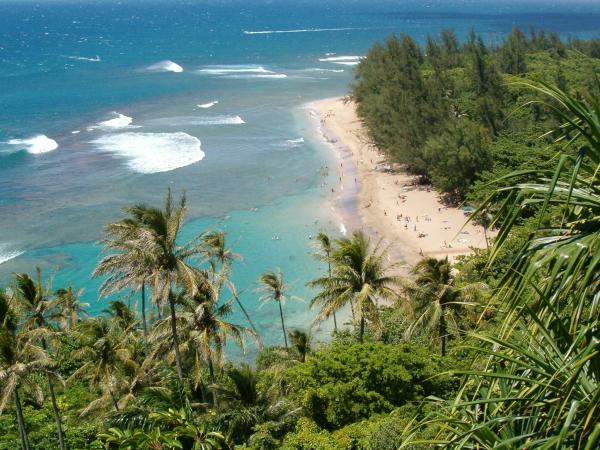
Kee Beach seen from the first lookouts along the Kalalau trail
Someone should thank you for this post. It’s VERY informative. Allow me to do so. I’ve hiked Kalalau and wish I would have read this (or your previous Kalalau post) before the attempt. Thanks again, Andy.
MM
P.S. Your thoughts on the tunnel hike as mentioned by you and “Ultimate Kauai Guidebook” would be greatly appreciated…and don’t think of it as charity..these will make great additions to your future book!
I tried posting this comment before, but it didn’t go through for some reason.
I hiked the Kalalau trail about 13 years ago in October. It was not only my first backpacking trip, but it was my first solo backpacking trip. It was awesome.
There is one danger that I didn’t find mentioned in your post or in one of your referenced sources. It involves the kukui nut tree. While at Kalalau beach, I was enjoying some vegetarian chili with the “hippies” and listening to one of them talk about the dangers of kukui nut trees. He said that they tend to drop their branches after heavy rains, and he related a very engrossing story about some Japanese tourists who were nearly clobbered by a kukui nut tree branch.
When it was time to go to bed, I walked back to my campsite and found a massive tree branch had fallen right across my tent. It had come down with such force that the metal tent spikes were thrown clear of the camp site and bent beyond usefulness. If I had been in that tent when the branch had fallen, I would probably be dead now. God must have been watching over me during that trip.
So, the obvious moral of the story is: DON’T CAMP UNDER A KUKUI NUT TREE.
I am hiking the Kalalau in Mid September. Still in the early stages of logistics, but we will be doing it in 4 days (one in and one out and 2 beach days). We are staying overnight in Lihue the night before the hike. What is the drive time from Lihue to the trail head? Some entries say leave super early (as with all hikes;-), so is that reasonable to say we could make that drive in, say, a couple hours?
Ralph – you are going to have to drive from Lihue to Haena, google maps says its less than 40 miles but I would allocate 1.5-2 hrs, much of the driving on the north shore is very very slow, crossing single lane bridges waiting on traffic, plus finding parking at the trailhead took some time when i’ve been myself…
how do i hike from the beach at kalaulau to big pool? i’ve tried 3 times and never found it!
My wife and I are huge movie buffs and want to do the hike to kalalau beach specifically to try and make it to Honopu Arch. We will be going in late April, is it possible we could swim there during that time of year? Do we have to worry about being swept to sea, smashed against rocks or eaten by sharks? I know it’s only about 230 yards, but that’s a long way in those conditions…if swimming is not the answer how can we get there?
I live here on Kauai, but I’m about to embark on my first trip into Kalalau. Being friends with many of the ‘hippies’ that go in regularly, it is understood to be helpful to come into the valley with trade items. I’ve been searching for any ideas outside of the usual suggestions like coffee, rolling tobacco and honey. I thought you might like to add a section covering this … ;0)
I recently got back from a trip to Kalalau I took with my girlfriend, and saw something there that I’ve found almost nothing about anywhere on the web. At the end of the beach, closest to Honopu, we encountered a cave with about 100 or so rock structures that had been created from the stones in the cave. They were all balanced and stacked in seemeingly gravity defying manner, and happening upon them unexpectedly was otherworldly, even mystical. They’re like altars, in a way. It was like uncovering Stonehenge… I’ve looked for stories and pictures on the net, but only found mention of them twice. Do you know anything about them?
In 1968, when I was a young teenager, I hiked into Kaualau with my family including my younger brother. We camped near the beach. My brother and I swam over to Honopu and found a waterfall just west of the arch. There was a rope up to the lip of the falls which we climbed up. We started boulder hopping up the valley. This grizzly Hawaiian blocks our path and told us to go back that this was sacred ground-Of course we did. So we swam back to Kaualau and decided to explore the valley. We meet this same Hawaiian coming down the trail. We couldn’t figure out how he got around us.. Back in Hanalei this local told us there was a secret tunnel connecting the two valleys. I don’t really believe that but it is fun to think about.
Has anyone ever seen the black fin tucked into the volcanic rock right at the launch point to Honopu? There is a handwritten note describing one person’s adventure tucked inside of the fin.